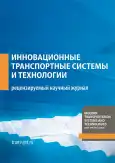Совершенствование качества обслуживания малоподвижных групп населения на железнодорожном транспорте путем устранения дополнительных барьеров в процессе выбора ими поездов
- Авторы: Завьялов А.Б.1, Глухих Т.В.1
-
Учреждения:
- Петербургский государственный университет путей сообщения Императора Александра I
- Выпуск: Том 10, № 4 (2024)
- Страницы: 489-503
- Раздел: Обзоры
- URL: https://bakhtiniada.ru/transj/article/view/277921
- DOI: https://doi.org/10.17816/transsyst636635
- ID: 277921
Цитировать
Полный текст
Аннотация
Цель. Улучшение качества обслуживания малоподвижных групп населения (МГН)на железнодорожном транспорте на территории северо-западного федерального округа для социализации данной группы населения с помощью предложения о включении дополнительного вагона со специальными местами для МГН и сопровождающих в поезда дальнего следования.
Материалы и методы. Статистический анализ количества МГН, пользующихся железнодорожным сообщением на территории СЗФО, анкетный опрос с привлечением общественных организаций, ассоциаций по вопросам МГН для выявления текущих недостатков, с которыми сталкиваются данная категория пассажиров в пути следования, предложение включить в поезда дальнего следования популярных среди населения маршрутов вагона с специальным купе для МГН и их сопровождающих.
Результаты. С помощью графической диаграммы построены связи между всеми участниками процесса включения дополнительного вагона с купе для МГН в состав поездов для упрощения процесса выбора необходимых поездов данной группой населения.
Заключение. Улучшение качества обслуживания, исключение необходимости заранее узнавать у перевозочной компании о наличии специальных купе для МГН и их сопровождающих в поездах дальнего следования, увеличение спроса на перемещение железнодорожным транспортом подтолкнет к решению проблем перемещения МГН на других видах транспорта
Полный текст
Открыть статью на сайте журналаОб авторах
Алексей Борисович Завьялов
Петербургский государственный университет путей сообщения Императора Александра I
Автор, ответственный за переписку.
Email: alzav1310@gmail.com
ORCID iD: 0009-0008-6160-455X
SPIN-код: 4123-8950
ассистент
Россия, Санкт-ПетербургТатьяна Владимировна Глухих
Петербургский государственный университет путей сообщения Императора Александра I
Email: gluhih_tv@mail.ru
ORCID iD: 0009-0001-6422-8421
студент
Россия, Санкт-ПетербургСписок литературы
- Zavyalov AB. Ergonomic analysis of the workplace of a person with disabilities using interactive tools / Avtomobil’nye dorogi i transportnaya infrastruktura. 2024;1:153–158. (In Russ.) [cited 2024 September 18]. Available from: https://www.elibrary.ru/download/elibrary_65668277_96658456.pdf EDN: ZUEVPR
- Dejeammes M. Boarding aid devices for disabled passengers an heavy rail. Evaluation of accessibility. In: Railroad Track Engineering snd Maintenance; Passenger Rail Planning and Operations: Rail. Transportation Research Record. 79th Annual Meeting of the Transportation-Research-Board. 2000;1713:48–55. doi: 10.3141/1713-07
- Padzi FA, Ibrahim F. Accessibility of Visually Impaired Passengers at Urban Railway Stations in the Klang Valley. International Transaction Journal of Engineering Management & Applied Sciences & Technologies. 2012;3(3):277–292. doi: 10.1016/j.sbspro.2014.07.306
- Du JB, Qiao FX, YuL. Improving Bus Transit Services for Disabled Individuals: Demand Clustering, Bus Assignment, and Route Optimization. IEEE ACCESS. 2020;8:121564–121571. doi: 10.1109/ACCESS.2020.3007322
- Chogovadze J, Gogiashvili P, Lekveishvili G, Kbilashvili D, Mardaleishvili N. Mathematical Modeling of the Motion Parameters of a Disabled Person in a Bus. Transport Problems. 2020;15(1):49–59. doi: 10.21307/tp-2020-005
- Budd L, Ison S. Supporting the needs of special assistance (including PRM) passengers: An international survey of disabled air passenger rights legislation. Journal of Air Transport Management. 2020;87:114–118. doi: 10.1016/j.jairtraman.2020.101851
- Chang YC, Chen CF. Meeting the needs of disabled air passengers: Factors that facilitate help from airlines and airports. In: Tourism Management. 2012;33(3):529–536. doi: 10.1016/j.tourman.2011.06.002
- Paananen K, Minoia P. Cruisers in the City of Helsinki: staging the mobility of cruise passengers. Tourism Geographies. 2019;21(5):801–821. doi: 10.1080/14616688.2018.1490341
- Chou CC, Tsai CL, Wong CP. A Study on Boarding Facilities on Wharves and Ships for Disabled and Elderly Passengers Using Public Shipping Transport. Journal Of Transport & Health. 2020;18:185–198. doi: 10.1016/j.jth.2020.100895
- Federal State Statistics Service. [Internet]. (In Russ.) [cited 2024 September 18]. Available from: https://rosstat.gov.ru/folder/13964
- Timakova RT, Ilyukhina YuV. Modern trends of sustainable development of “accessible environment” on the railway transport. Bulletin of Voronezh State University of Engineering Technologies. 2022;84(1):410–417. doi: 20914/2310-1202-2022-1-410-417 EDN: SMUTMG
- Terekhova IR, Levanchuk LA. Evacuatoin of small-mobility groups in the event of fire hazardous situations at railway transport facilities / V sbornike: Problemy obespecheniya bezopasnosti (Bezopasnost’ 2020). Materialy II Mezhdunarodnoy nauchno-prakticheskoy konferentsii. 2020:221–225. (In Russ.) [cited 2024 September 18]. Available from: https://www.elibrary.ru/download/elibrary_42776313_68801247.pdf EDN: WUGAKW
- Terentyev YuA, Filimonov VV, Malinetskiy GG. Russia integrated transit transport system basid on vacuum magnetic levitation transport. Transportation Systems and Technology. 2018;4(3):57–84. doi: 10.17816/transsyst201843s157-84
- Kanonin YuN. Safety issues in the operation of highly automated vehicles. Izvestiya Peterburgskogo universiteta putej soobshcheniya. 2024;21(1):76–84. doi: 10.20295/1815-588X-2024-01-76-84 EDN: ITCNAG
- Ershova S, Orlovskaya T, Panfilova E. Study of Life Quality and Urban Environment Quality in Russian Megapolises. IOP Conference Series: Materials Science and Engineering, 2018;463(4):042040. doi: 10.1088/1757-899X/463/4/042040 EDN: UQGSZQ
Дополнительные файлы













